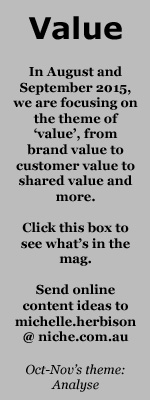Data: cost versus value for brands
Share

The true value in data is knowing as much as you can about your audience, writes Trent Lloyd.
 In programmatic trading land ‘more’ data is definitely more. The more data points marketers have about an individual, the more likely they are to be able to build a valuable profile of them as a human being.
In programmatic trading land ‘more’ data is definitely more. The more data points marketers have about an individual, the more likely they are to be able to build a valuable profile of them as a human being.
Until recently it’s all been about harvesting data, but finally we’re moving into a far more exciting phase of actually using data.
It’s no longer a case of whether or not advertisers need ‘big data’.
It’s a case of who has the best data combination in the race to unlock the greatest audience value.
Data points are worth much more when they’re combined with other data. There’s a lot of value gained from combining different sources and modelling it so that related data can link advertisers to the same person, particularly across devices.
But unless you’re using data in a smart and unique way it could actually end up costing you more too.
Using data can drive up the price of advertising
As an advertiser, when there’s a lot of demand for particular segments, this pushes the price of digital inventory up.
If you liken it to traditional TV buying: if you buy a prime time ad spot like a TVC in the AFL Grand Final, it is going to cost a lot more because it’s been pre-identified as huge audience.
When you start using audience data with specific segments you’re actually pre-identifying whom you’re going to deliver your message to, and who is going to respond.
For example, a very specific segment would be: females aged 25 to 30 who live in Melbourne and are in the market to buy a car.
Several major advertisers may be targeting this particular segment.
When buying programmatically then you’re buying the inventory that these people come to on an auction basis – so when these ‘females aged 25 to 30 who live in Melbourne and are in the market to buy a car’ come online, there are a lot of advertisers fighting to serve them impressions – all using the same standard segment data.
In programmatic marketing it’s the same, the price goes up when a lot more buyers are vying for the same audiences.
The perceived value of first, second and third party data
There’s a perception that these labels refer to three tiers of data quality; for example, ‘best’, ‘second best’, ‘last resort’.
However, each type of data adds value in its own right.
First party data is perceived as the top tier, but if you are not collecting and using it properly, or if your first party data is limited in scale or quality, then you are missing out on a massive marketing opportunity to learn about your current customers.
But the most valuable databases don’t always live within a brand marketer’s headquarters.
Prospecting for new customers is actually impossible with first party data alone. If you only have information that you collected yourself (first party) it’s only going to be about your current customers.
Brands need a much more rounded view of the world than that.
But whether you sourced it from your own data gathering assets, or you acquire this data it’s not ‘second hand’.
It’s the same data.
The data’s value lies in how it’s activated.
Use whatever data it takes, just find the high-value audiences
Many advertisers have a lot of data but they still don’t know what makes up their best performing audience. Having more visibility into high-value audiences, gives brands the opportunity to find more high-value and high-performing audiences.
The nature of buying media on an auction basis means it’s natural that that the most valuable audiences may cost more to reach. But at least you know that’s a valuable investment.
As competition gets stiffer, marketers will become more competitive and need to employ different and smarter programmatic tools, techniques and data to stay in the game.
Rather than just looking at how campaigns performed in isolation, brands are seeing value in data and what it can do for them, both in real-time and longer term.
It has always cost marketers money to find their audiences. Programmatic promises to do this quicker and better – but the true value lies in knowing all you possibly can about your intended audience in the first place.
Trent Lloyd is Eyeota co-founder and GM publisher development.















